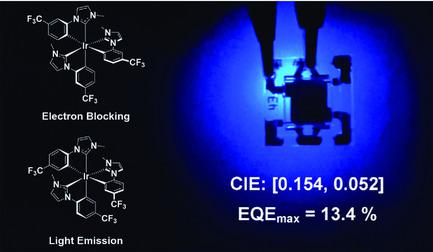当前位置:
X-MOL 学术
›
Adv. Mater.
›
论文详情
Our official English website, www.x-mol.net, welcomes your
feedback! (Note: you will need to create a separate account there.)
High‐Efficiency Deep‐Blue‐Emitting Organic Light‐Emitting Diodes Based on Iridium(III) Carbene Complexes
Advanced Materials ( IF 27.4 ) Pub Date : 2018-10-15 , DOI: 10.1002/adma.201804231 Amlan K. Pal 1 , Simonas Krotkus 2 , Mattia Fontani 1, 3, 4 , Campbell F. R. Mackenzie 1 , David B. Cordes 1 , Alexandra M. Z. Slawin 1 , Ifor D. W. Samuel 2 , Eli Zysman‐Colman 1
Advanced Materials ( IF 27.4 ) Pub Date : 2018-10-15 , DOI: 10.1002/adma.201804231 Amlan K. Pal 1 , Simonas Krotkus 2 , Mattia Fontani 1, 3, 4 , Campbell F. R. Mackenzie 1 , David B. Cordes 1 , Alexandra M. Z. Slawin 1 , Ifor D. W. Samuel 2 , Eli Zysman‐Colman 1
Affiliation

|
High‐efficiency pure blue phosphorescent organic light‐emitting diodes (OLEDs) remain one of the grand challenges, principally because the emissive complexes employed either do not possess sufficiently high photoluminescence quantum yields or exhibit unsatisfactory Commission International de l'Éclairage (CIE) coordinates. Here two deep‐blue‐emitting homoleptic iridium(III) complexes are reported and OLEDs are demonstrated with CIE coordinates of (0.15, 0.05) and maximum external quantum efficiency of 13.4%, which decreases slightly to 12.5% at 100 cd m−2. They represent examples of the most efficient OLEDs surpassing the CIEy requirement of the National Television System Committee (NTSC) and the European Broadcasting Union (EBU). Emitter orientation contributes to the excellent device performance.
中文翻译:

基于铱(III)碳配合物的高效深蓝色发光有机发光二极管
高效的纯蓝色磷光有机发光二极管(OLED)仍然是一大挑战,主要是因为所采用的发射复合物要么没有足够高的光致发光量子产率,要么表现出令人满意的国际照明委员会(CIE)坐标。在此报道了两种发出深蓝光的均质铱(III)配合物,并证明了OLED的CIE坐标为(0.15,0.05),最大外部量子效率为13.4%,在100 cd m -2时略有下降,降至12.5%。它们代表了超过国家电视系统委员会(NTSC)和欧洲广播联盟(EBU)的CIEy要求的最高效OLED的示例。发射极定向有助于出色的设备性能。
更新日期:2018-10-15
中文翻译:

基于铱(III)碳配合物的高效深蓝色发光有机发光二极管
高效的纯蓝色磷光有机发光二极管(OLED)仍然是一大挑战,主要是因为所采用的发射复合物要么没有足够高的光致发光量子产率,要么表现出令人满意的国际照明委员会(CIE)坐标。在此报道了两种发出深蓝光的均质铱(III)配合物,并证明了OLED的CIE坐标为(0.15,0.05),最大外部量子效率为13.4%,在100 cd m -2时略有下降,降至12.5%。它们代表了超过国家电视系统委员会(NTSC)和欧洲广播联盟(EBU)的CIEy要求的最高效OLED的示例。发射极定向有助于出色的设备性能。











































 京公网安备 11010802027423号
京公网安备 11010802027423号